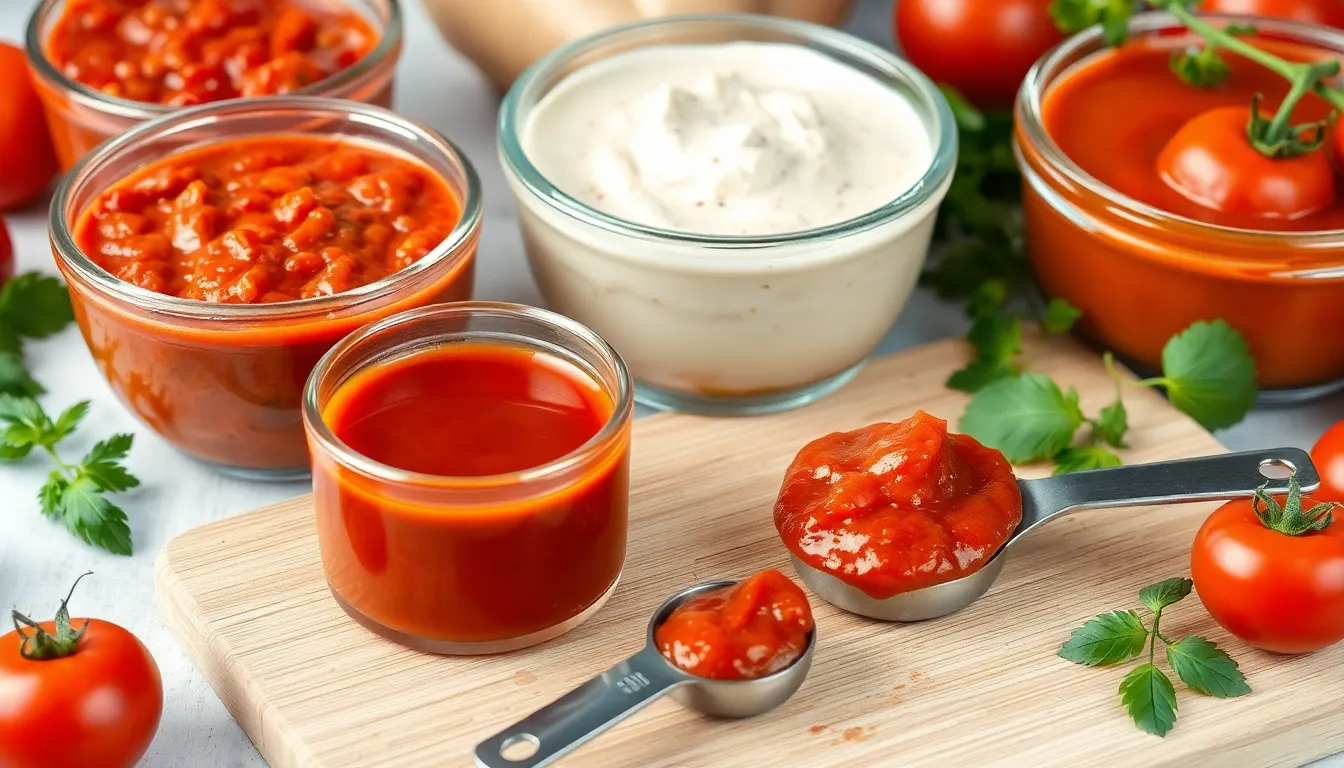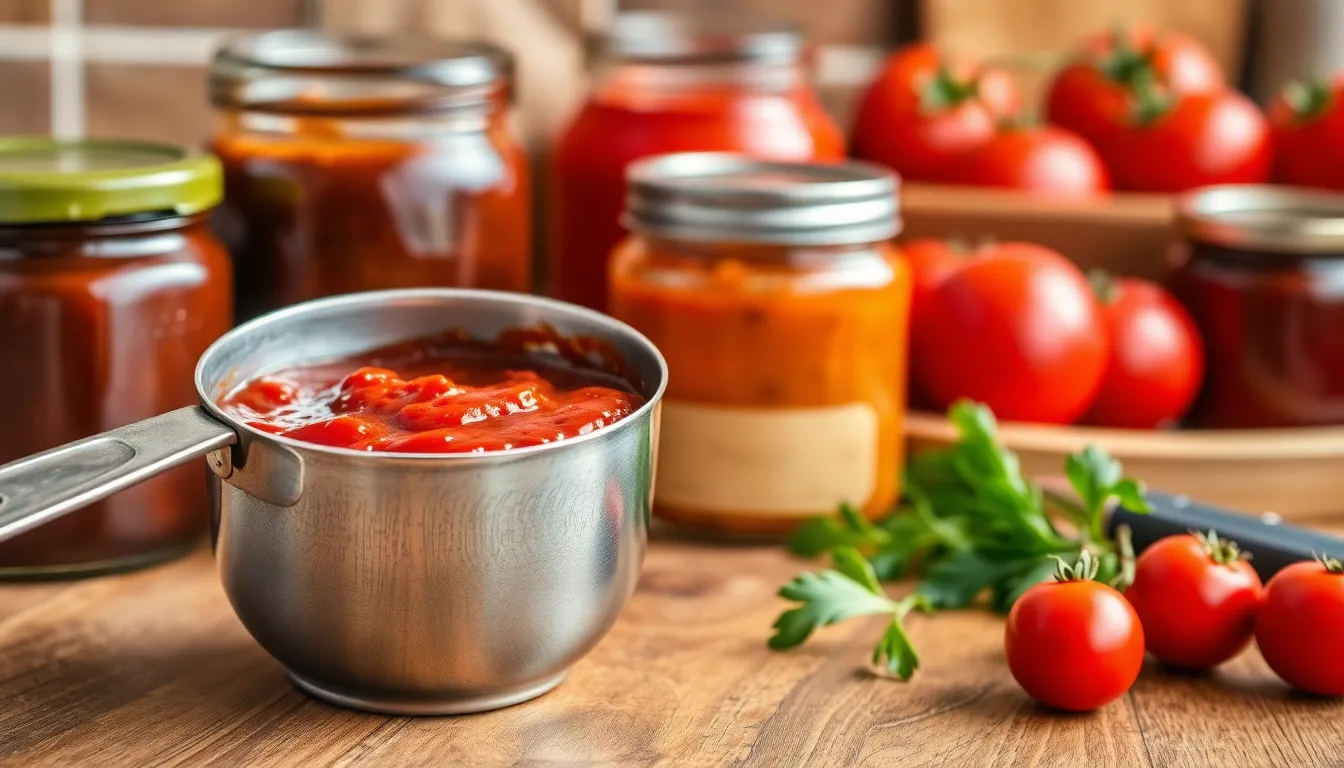Table of Contents
ToggleWhen it comes to cooking, few things are as versatile as tomato sauce. It’s the superhero of the kitchen, saving bland dishes and transforming them into flavor-packed masterpieces. But wait—what’s the secret to achieving that perfect sauce? It all boils down to the tomato paste to sauce ratio.
Understanding Tomato Paste to Sauce Ratio
Tomato paste serves as a concentrated flavor enhancer in sauces. Ratios generally depend on a recipe’s requirements and desired thickness. A common ratio is one part tomato paste to three parts sauce, which creates a rich, flavorful blend.
Special occasions may call for a different approach. For instance, using two parts tomato paste to three parts sauce results in a bolder taste. Adjustments can also factor in other ingredients. Adding herbs or spices might necessitate a softer balance, making a one-to-four ratio more suitable.
Acidity levels play a significant role too. This prevents an overpowering taste in dishes like marinara or Bolognese. When using fresh tomatoes or canned sauce, incorporating more tomato paste enhances consistency without sacrificing flavor.
Cooking times affect these ratios. This means longer cooking times allow flavors to meld, requiring adjustments to the paste and sauce blend. For quick meals, one-to-two ratios can expedite preparation while maintaining taste.
Ultimately, personal preference dictates successful adjustments. Experimenting can yield optimal results tailored to individual palates. Keeping ratios in mind enables cooks to elevate their dishes, creating a balanced and enjoyable tomato sauce every time.
Factors Influencing Tomato Paste to Sauce Ratio


Several factors affect the tomato paste to sauce ratio. Understanding these elements enhances cooking experiences and results in more flavorful dishes.
Type of Sauce
Different types of sauces require unique ratios of tomato paste. Marinara sauce typically demands a standard ratio of one part tomato paste to three parts sauce for balanced flavor. Conversely, a pizza sauce might benefit from a ratio of one to two, concentrating flavors for that bold taste. When preparing a creamy tomato sauce, the ratio might shift further, allowing for more paste to establish richness. Additionally, recipes for stuffed pasta may call for thicker sauce, increasing the amount of tomato paste.
Desired Consistency
Desired consistency plays a crucial role in determining the ratio of tomato paste to sauce. For a thicker sauce, using a higher proportion of tomato paste enhances texture and flavor depth. Alternatively, those seeking a lighter sauce can reduce the amount of tomato paste, creating a more fluid result. Soups or stews often blend tomato paste in smaller quantities, allowing other ingredients to shine. Adjusting the ratio according to personal preference leads to customizable culinary experiences that suit individual tastes.
Common Ratios for Different Sauces
Understanding the tomato paste to sauce ratio helps achieve the best flavor and consistency in various sauces. Here are some common ratios for different types of sauces.
Marinara Sauce
Marinara sauce typically employs a one-to-three ratio of tomato paste to sauce. This ratio allows for a balanced flavor without overwhelming the dish. When making marinara, consider adding garlic, onions, and olive oil for depth. Those who prefer a thicker consistency can opt for a one-to-two ratio, enhancing the sauce’s richness. Adjusting the herbs, such as basil or oregano, further personalizes the taste, creating a unique culinary experience.
Pizza Sauce
A one-to-two ratio of tomato paste to sauce works well for pizza sauce. This ratio provides the bold flavor that complements pizza toppings effectively. Making pizza sauce is simple; blend tomato paste with spices like garlic powder or dried oregano. The thicker consistency adheres better to crusts, ensuring each bite is flavorful. Additionally, including a touch of sugar may balance acidity, enhancing overall taste.
Bolognese Sauce
Bolognese sauce often requires a one-to-four ratio of tomato paste to sauce for a smoother texture. This ensures the sauce remains rich without dominating the dish. Incorporating ground meat, carrots, and celery also adds depth to Bolognese. A slightly longer cook time allows the flavors to meld beautifully, making this sauce a favorite in many households. Adjust this ratio based on preference, either for a thicker or lighter version, ensuring satisfaction with each serving.
Adjusting Tomato Paste to Sauce Ratio
Finding the right balance between tomato paste and sauce enhances flavor. Adjustments depend on personal taste and dish requirements.
Taste Adjustments
Balancing flavors relies on tomato paste’s concentrated nature. For a bolder taste, reduce the sauce quantity. A one-to-two ratio often intensifies flavors, ideal for robust dishes. Adding ingredients like garlic or onion changes the flavor profile; therefore, an adjustment to the paste ratio may complement those additions. Conversely, if using milder spices, increasing the sauce might create a more harmonious blend. Experimenting with ratios provides opportunities to discover unique flavor combinations that suit individual preferences.
Cooking Techniques
Cooking methods impact tomato paste’s effectiveness in sauces. Sautéing paste before combining it with sauce releases natural sugars and enhances richness. A long simmer melds flavors beautifully, allowing a one-to-three ratio to work perfectly. Quick meals, however, benefit from a more concentrated blend, where a one-to-two ratio delivers immediate flavor. When making soups or stews, incorporating tomato paste gradually allows for a smoother integration with other ingredients. Adjusting ratios based on cooking techniques results in flavorful dishes tailored to personal taste.







